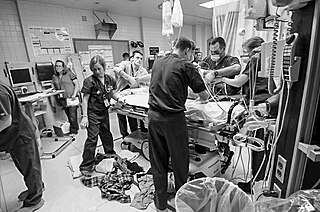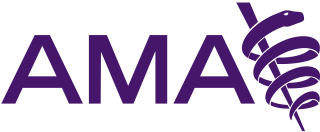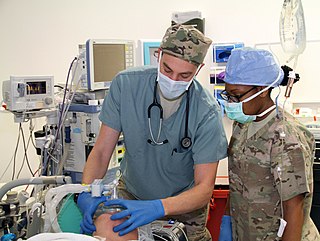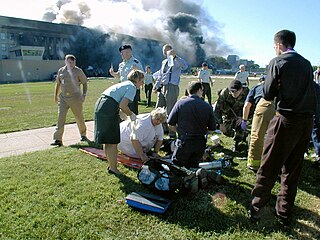
Medical psychology, or Medico-psychology, is the application of psychological principles to the practice of medicine, primarily drug-oriented, for both physical and mental disorders.

Emergency medicine is the medical speciality concerned with the care of illnesses or injuries requiring immediate medical attention. Emergency physicians continuously learn to care for unscheduled and undifferentiated patients of all ages. As first-line providers, in coordination with Emergency Medical Services, they are primarily responsible for initiating resuscitation and stabilization and performing the initial investigations and interventions necessary to diagnose and treat illnesses or injuries in the acute phase. Emergency physicians generally practise in hospital emergency departments, pre-hospital settings via emergency medical services, and intensive care units. Still, they may also work in primary care settings such as urgent care clinics.
In the medical profession, a general practitioner (GP) is a physician who treats acute and chronic illnesses and provides preventive care and health education to patients of all ages. Their duties are not confined to specific fields of medicine, and they have particular skills in treating people with multiple health issues. They are trained to treat patients to levels of complexity that vary between countries.

The American Medical Association (AMA) is a professional association and lobbying group of physicians and medical students. Founded in 1847, it is headquartered in Chicago, Illinois. Membership was approximately 240,000 in 2016.

Anesthesiology, anaesthesiology, or anaesthesia is the medical specialty concerned with the total perioperative care of patients before, during and after surgery. It encompasses anesthesia, intensive care medicine, critical emergency medicine, and pain medicine. A physician specialized in anesthesiology is called an anesthesiologist, anaesthesiologist, or anaesthetist, depending on the country. In some countries, the terms are synonymous, while in other countries they refer to different positions and anesthetist is only used for non-physicians, such as nurse anesthetists.
International emergency medicine is a subspecialty of emergency medicine that focuses not only on the global practice of emergency medicine but also on efforts to promote the growth of emergency care as a branch of medicine throughout the world. The term international emergency medicine generally refers to the transfer of skills and knowledge—including knowledge of ambulance operations and other aspects of prehospital care—from developed emergency medical systems (EMSs) to those systems which are less developed. However, this definition has been criticized as oxymoronic, given the international nature of medicine and the number of physicians working internationally. From this point of view, international emergency medicine is better described as the training required for and the reality of practicing the specialty outside of one's native country.

Family medicine is a medical specialty within primary care that provides continuing and comprehensive health care for the individual and family across all ages, genders, diseases, and parts of the body. The specialist, who is usually a primary care physician, is named a family physician. It is often referred to as general practice and a practitioner as a general practitioner. Historically, their role was once performed by any doctor with qualifications from a medical school and who works in the community. However, since the 1950s, family medicine / general practice has become a specialty in its own right, with specific training requirements tailored to each country. The names of the specialty emphasize its holistic nature and/or its roots in the family. It is based on knowledge of the patient in the context of the family and the community, focusing on disease prevention and health promotion. According to the World Organization of Family Doctors (WONCA), the aim of family medicine is "promoting personal, comprehensive and continuing care for the individual in the context of the family and the community". The issues of values underlying this practice are usually known as primary care ethics.
Founded in 1954 and chartered as a non-profit organization in 1956, the American College of Preventive Medicine (ACPM) is an American physicians' organization focused on practice, research, publication, and teaching of evidence-based preventive medicine. It publishes the American Journal of Preventive Medicine, which is their official journal.

The American Osteopathic Association (AOA) is the representative member organization for the more than 145,000 osteopathic medical doctors (D.O.s) and osteopathic medical students in the United States. The AOA is headquartered in Chicago, Illinois, and is involved in post-graduate training for osteopathic physicians. Beginning in 2015, it began accrediting post-graduate education as a committee within the Accreditation Council for Graduate Medical Education, creating a unified accreditation system for all DOs and MDs in the United States. The organization promotes public health, encourages academic scientific research, serves as the primary certifying body for D.O.s overseeing 18 certifying boards, and is the accrediting agency for osteopathic medical schools through its Commission on Osteopathic College Accreditation. As of October 2015, the AOA no longer owns the Healthcare Facilities Accreditation Program (HFAP), which accredited hospitals and other health care facilities.
A medical specialty is a branch of medical practice that is focused on a defined group of patients, diseases, skills, or philosophy. Examples include children (paediatrics), cancer (oncology), laboratory medicine (pathology), or primary care. After completing medical school, physicians or surgeons usually further their medical education in a specific specialty of medicine by completing a multiple-year residency to become a specialist.
Disaster medicine as a specialty and mindset was not only a reaction from September 11, 2001, but to the numerous subsequent events that seemed to all too quickly follow: random anthrax attacks, the SARS outbreak, the New York City blackout in the summer of 2003, the December 26, 2004 Indian Ocean earthquake and tsunami, the Pakistan earthquake of 2005, tumultuous hurricane seasons in 2004 and 2005 and, of course, terrorist attacks throughout the world — all against a backdrop of conflict in Afghanistan and Iraq.
The medical establishment in North America and the United Kingdom began forming study and discussion groups in disaster medicine. In some cases, the medical schools were on the front lines of this movement. Meanwhile, courses and fellowships in disaster medicine related fields at universities in London, Paris, Brussels, Bordeaux and the United States have been in existence since the early 1980s.
Throughout this period, incomplete and faltering medical responses to disaster events made it increasingly apparent that federal, state and local emergency management organizations were in need of a mechanism to identify qualified physicians in the face of a global upturn in the rate of natural and man-made disasters. Many physicians who volunteer at disasters have a bare minimum of knowledge in disaster medicine and often pose a hazard to themselves and the response effort because they have little or no field response training. It was against this backdrop that the American Academy of Disaster Medicine (AADM) and the American Board of Disaster Medicine (ABODM) were formed for the purpose of scholarly exchange and education in Disaster Medicine as well as the development of an examination demonstrating excellence towards Board Certification in this new specialty.
Board certification is the process by which a physician or other professional demonstrates a mastery of advanced knowledge and skills through written, practical, or simulator-based testing.
The American Board of Physician Specialties (ABPS), the official certifying body for the American Association of Physician Specialists (AAPS) is a non-profit umbrella organization for sixteen medical specialty boards that certifies and re-certifies physicians in fourteen medical specialties in the United States and Canada. The ABPS is one of three organizations overseeing Doctor of Medicine (M.D.) and Doctor of Osteopathic Medicine (D.O.) certification in the United States. The ABPS assists its Member Boards in developing and implementing educational and professional standards to evaluate and certify physician specialists. It is recognized by the U.S. Department of Labor as well as the Centers for Medicare and Medicaid Services (CMS).
The American Association of Physician Specialists, Inc. (AAPS) is a 501(c)(6) not-for-profit organization founded in 1950, with headquarters in Tampa, Florida. The AAPS was first organized to provide specialty certification for physicians who had obtained advanced training in various areas of medical specialty. AAPS was the first organization of its kind to accept both M.D. and D.O. physicians as full members, in contrast to the American Board of Medical Specialties which was initially limited to those with a M.D.
Established in 1939, the American Osteopathic Association Bureau of Osteopathic Specialists (AOABOS) is a non-profit umbrella organization for 18 medical specialty boards in the United States. Along with the American Board of Medical Specialties (ABMS) and the American Board of Physician Specialties (ABPS), the AOABOS is one of three leading entities that oversees physician board certification in the United States. The AOABOS assists its Member Boards in developing and implementing educational and professional standards to evaluate and certify physician specialists.

Disaster medicine is the area of medical specialization serving the dual areas of providing health care to disaster survivors and providing medically related disaster preparation, disaster planning, disaster response and disaster recovery leadership throughout the disaster life cycle. Disaster medicine specialists provide insight, guidance and expertise on the principles and practice of medicine both in the disaster impact area and healthcare evacuation receiving facilities to emergency management professionals, hospitals, healthcare facilities, communities and governments. The disaster medicine specialist is the liaison between and partner to the medical contingency planner, the emergency management professional, the incident command system, government and policy makers.

The Brooklyn Hospital Center is a 464-licensed-bed, full-service community teaching hospital located in Downtown Brooklyn, New York City. The hospital was founded in 1845. It is affiliated with the Mount Sinai Health System, and serves a diverse population from a wide range of ethnic backgrounds.

Physicians in the United States are doctors who practice medicine for the human body. They are an important part of health care in the United States. The vast majority of physicians in the US have a Doctor of Medicine (MD) degree, though some have a Doctor of Osteopathic Medicine (DO) or Bachelor of Medicine, Bachelor of Surgery (MBBS).

The International Federation for Emergency Medicine (IFEM) is an organisation promoting international emergency medicine around the world. It is a consortium of over 60 national emergency medicine organisations. IFEM organises the International Conference on Emergency Medicine (ICEM).
Frederick M. "Skip" Burkle, Jr. is an American physician known for his work in human rights, international diplomacy and peacemaking, humanitarian assistance, and disaster response. He has been called "the single most talented and experienced post-conflict health specialist working for the United States government." His medical qualifications include pediatrics, emergency medicine, psychiatry, public health, and tropical medicine.









